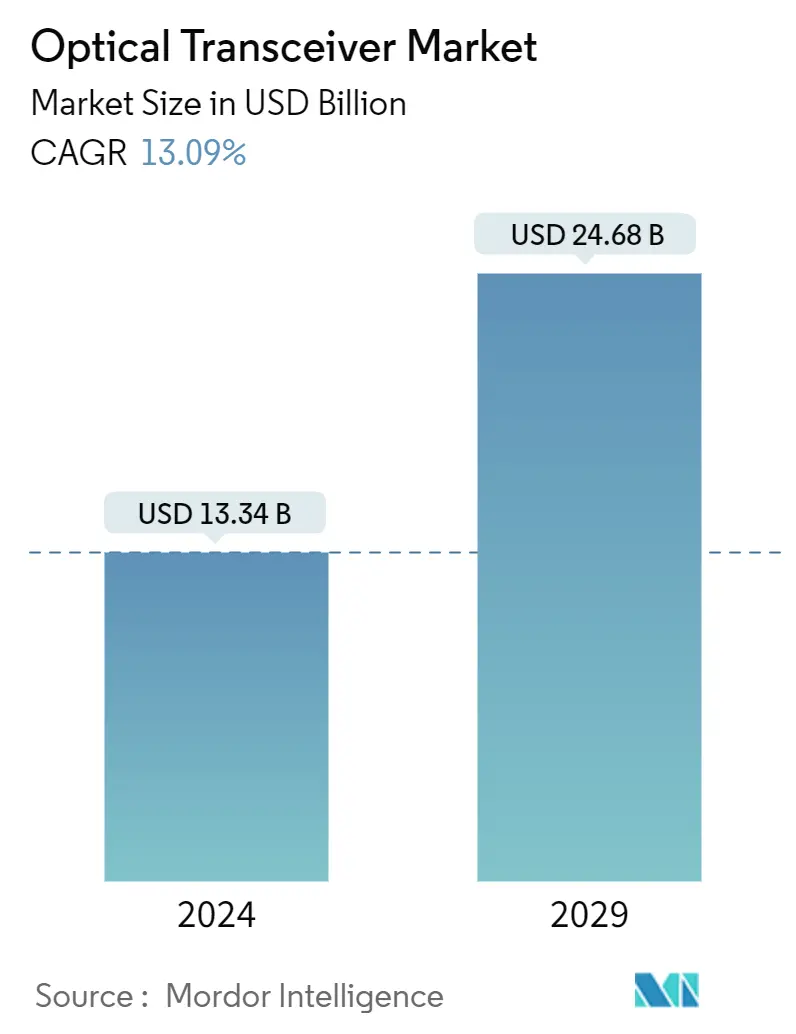Market Size of Optical Transceiver Industry

| Study Period | 2019 - 2029 |
| Market Size (2024) | USD 13.34 Billion |
| Market Size (2029) | USD 24.68 Billion |
| CAGR (2024 - 2029) | 13.09 % |
| Fastest Growing Market | Asia Pacific |
| Largest Market | North America |
Major Players
*Disclaimer: Major Players sorted in no particular order |
Optical Transceiver Market Analysis
The Optical Transceiver Market size is estimated at USD 13.34 billion in 2024, and is expected to reach USD 24.68 billion by 2029, growing at a CAGR of 13.09% during the forecast period (2024-2029).
An optical transceiver, also known as a fiber optic transceiver, is an interconnect component used to transmit and receive data in a fiber-optic network. It consists of two main parts: a transmitter and a receiver. The transmitter converts electrical signals into light signals, which are transmitted through fiber optic cables. The receiver, on the other hand, receives light signals and converts them back into electrical signals.
- Optical transceivers enable high-speed data transmission over long distances. They can support high bandwidth applications like video streaming, cloud computing, and data centers. They can transmit data over long distances without significant signal degradation. They are commonly used in telecommunications and networking applications that require data transmission over kilometers of fiber optic cables.
- Due to several factors, the telecom industry is experiencing an increasing need for advanced communication. These factors include the demand for energy efficiency, the focus on delivering advanced connectivity, and the rise of new technologies such as the Internet of Things (IoT) and artificial intelligence (AI). Telecom companies strive to deliver advanced connectivity and higher performance to their customers. This includes deploying technologies like 5G, edge computing, and improved network infrastructure. These advancements enable faster and more reliable communication services. The advanced development and upgrade of the bearer network is anticipated to drive the demand for optical communication network equipment to increase as 5G technology progresses and base stations are deployed.
- Cloud-based services have experienced a significant increase in demand in recent years. Cloud computing allows businesses to reduce their IT infrastructure costs by eliminating the need for on-premises servers and hardware. Instead, companies can access computing resources and services on demand, paying only for what they use. Cloud services also offer the ability to scale resources up or down based on demand. The increasing adoption of cloud services owing to their significant advantages would create massive demand for advanced communication infrastructure, thereby driving the optical transceivers market.
- Optical transceivers, such as data centers, are critical in high-capacity data transmission networks. In recent years, there has been an increase in network complexity in optical transceivers. The demand for high data rates in modern networks has led to the development of optical transceivers capable of transmitting data at speeds ranging from 1G to 400 G. The higher data rates require more sophisticated designs and technologies to ensure reliable and efficient data transmission.
- The outbreak of COVID-19 increased the usage of data. According to a report on the impact of the COVID-19 pandemic on China's entertainment industry by Maoyan Entertainment, a leading platform providing innovative Internet-empowered entertainment services in China, the movie industry was severely hit by the pandemic, whereas the online entertainment market, including TV and streaming platforms, were booming as people were confined to their homes. This has led to the growth of the market.
Optical Transceiver Industry Segmentation
An optical transceiver combines the functions of a transmitter and a receiver into a single device. Optical transceivers convert the electrical signal from a switch or router to an optical signal that can be transmitted and received in light pulses using fiber optic technology. This is accomplished at extremely high speeds and over large distances. It can be inserted into or implanted into another device that can send and receive data in a data network.
The optical transceiver market is segmented by protocol (ethernet, fiber channel, CWDM/DWDM, FTTX, other protocols), by data rate (less than 10 Gbps, 10 Gbps to 40 Gbps, 100 Gbps, greater than 100 Gbps), by application (data center, telecommunication), by geography (North America, Europe, Asia Pacific, Latin America, and the Middle East and Africa). The market sizes and forecasts are provided in terms of value in USD for all the above segments.
| By Protocol | |
| Ethernet | |
| Fiber Channel | |
| CWDM/DWDM | |
| FTTX | |
| Other Protocols |
| By Data Rate | |
| Less than 10 Gbps | |
| 10 Gbps to 40 Gbps | |
| 100 Gbps | |
| Greater than 100 Gbps |
| By Application | |
| Data Center | |
| Telecommunication |
| By Geography*** | |
| North America | |
| Europe | |
| Asia | |
| Australia and New Zealand | |
| Latin America | |
| Middle East and Africa |
Optical Transceiver Market Size Summary
The optical transceiver market is poised for significant growth, driven by the increasing demand for high-speed data transmission in telecommunications and networking applications. Optical transceivers, essential components in fiber-optic networks, facilitate the conversion of electrical signals to light signals and vice versa, enabling efficient data transfer over long distances. This technology is crucial for supporting high-bandwidth applications such as video streaming, cloud computing, and data centers. The market is experiencing a surge in demand due to the rapid advancement of communication technologies like 5G, IoT, and AI, which require enhanced connectivity and performance. The proliferation of cloud-based services and the need for advanced communication infrastructure further propel the market, as businesses increasingly rely on scalable and cost-effective solutions to manage their IT needs.
North America stands out as a significant contributor to the optical transceiver market, fueled by its robust communication landscape and high internet penetration. The region's adoption of advanced technologies and the presence of major data center companies like Google, Microsoft, and Amazon drive the demand for high-data-rate optical transceivers. The market is characterized by intense competition, with key players such as Coherent Corp., Accelink Technologies, and Lumentum Operations actively enhancing their product offerings through strategic partnerships and technological innovations. Recent advancements, including the introduction of ultracompact transceivers and high-speed optical modules, underscore the industry's commitment to meeting the growing demands of cloud-driven applications and AI-driven data processing. As data traffic continues to rise, the optical transceiver market is expected to expand, supported by ongoing investments in infrastructure and technology development.
Optical Transceiver Market Size - Table of Contents
-
1. MARKET INSIGHTS
-
1.1 Market Overview
-
1.2 Industry Value Chain Analysis
-
1.3 Industry Attractiveness - Porter's Five Forces Analysis
-
1.3.1 Bargaining Power of Suppliers
-
1.3.2 Bargaining Power of Buyers
-
1.3.3 Threat of New Entrants
-
1.3.4 Threat of Substitutes
-
1.3.5 Intensity of Competitive Rivalry
-
-
1.4 Impact of COVID-19 Aftereffects and Other Macroeconomic Factors on the Market
-
-
2. MARKET SEGMENTATION
-
2.1 By Protocol
-
2.1.1 Ethernet
-
2.1.2 Fiber Channel
-
2.1.3 CWDM/DWDM
-
2.1.4 FTTX
-
2.1.5 Other Protocols
-
-
2.2 By Data Rate
-
2.2.1 Less than 10 Gbps
-
2.2.2 10 Gbps to 40 Gbps
-
2.2.3 100 Gbps
-
2.2.4 Greater than 100 Gbps
-
-
2.3 By Application
-
2.3.1 Data Center
-
2.3.2 Telecommunication
-
-
2.4 By Geography***
-
2.4.1 North America
-
2.4.2 Europe
-
2.4.3 Asia
-
2.4.4 Australia and New Zealand
-
2.4.5 Latin America
-
2.4.6 Middle East and Africa
-
-
Optical Transceiver Market Size FAQs
How big is the Optical Transceiver Market?
The Optical Transceiver Market size is expected to reach USD 13.34 billion in 2024 and grow at a CAGR of 13.09% to reach USD 24.68 billion by 2029.
What is the current Optical Transceiver Market size?
In 2024, the Optical Transceiver Market size is expected to reach USD 13.34 billion.

